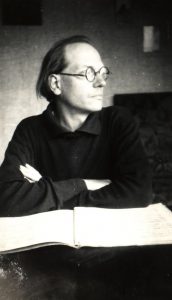
Yesterday’s Music History Monday post noted and celebrated the premiere of Olivier Messiaen’s Turangalîla Symphony in Boston, on December 2, 1949, by the Boston Symphony conducted by Leonard Bernstein. Composed between 1946 and 1948, the Turangalîla Symphony caps the first part of Messiaen’s compositional career.
There’s nothing else like it in the repertoire, for which we should probably be grateful; frankly, given its climax laden expressive content, I’m not sure any of us could survive listening to two works like the Turangalîla Symphony back-to-back.
The Turangalîla Symphony is 10-movement, 80 minute (that’s 1 hour, 20 minute) long Tantric orgasm, “rapturous overkill” in the words of one critic, “a sonic Mount Everest”, an almost non-stop exercise in rhapsodic bliss, amazing and a tad freaky. If the Turangalîla Symphony were itself a prolonged erection, the time to seek medical attention would have long since passed.
Messiaen (1908-1992) was fascinated by various Eastern cultures: their spirituality, rituals, and music, all of which are reflected in the Turangalîla Symphony. “Turangalîla” is a compound word in Sanskrit, meaning something on the lines of “a hymn of love to the play of joy, time, life and death.” A “hymn of ecstatic love” the piece most surely is. Its brilliant, shimmering, dazzling, blaring, pounding, singularly over-the-top orchestration (that’s “over-the-top” in italics, so over-the-usual-top is the orchestration!), enhanced by a virtuosic piano part and the sci-fi movie soundtrack sounds of the ondes martenot collectively make us wonder if this is, perhaps, something Claude Debussy might have written were he high (very high) on champignons magiques (magic mushrooms).
Writing in the Washington Post in 2001, Philip Kennicott observed that:
“Messiaen’s religion, a deeply Catholic faith based on a visionary connection with the natural world, inspired almost every piece he wrote. Despite its Sanskrit title, Turangalîla reflects a sensuous faith and pleasure in God’s world, in human love as a mirror of divine love.
Messiaen’s religiosity, his extravagant expression of faith through music, was not easily assimilated by the avant-garde of the middle years of the 20th century. Messiaen’s French music and Catholic faith stood almost entirely apart from the [modernistic] political world of musical manifestos and revolutions; he had admirers but few disciples, and his music was unclassifiable. He used almost every musical technique at his disposal, but always with a personal and transfiguring twist.”
Speaking of modernists: Messiaen’s former student, the strident, take-no-prisoners modernist Pierre Boulez (1925-2016) called the Turangalîla Symphony “vomit.” (Such a nice boy. Boulez, whose personal asexuality and asceticism have been compared to those of a Jainist monk, called Messiaen’s music of this period “brothel music”, presumably believing that to be an insult.)
Slightly less offensive was Igor Stravinsky’s reaction to the Turangalîla Symphony:
“Little more can be required to write such things than a plentiful supply of ink.”
(Another version of this story has Stravinsky saying that “all one needs to compose Turangalîla is enough manuscript paper.”)
Messiaen once said: “I’m not a theorist – only a believer, a believer dazzled by the infinity of God.” It has been suggested that in his Turangalîla Symphony, Messiaen actually reached out for that infinity, and further suggested that in the symphony he may even have touched it.… continue reading, and see the prescribed recording, only on Patreon!
